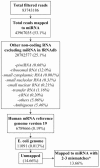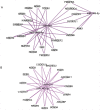Discovery and validation of Barrett's esophagus microRNA transcriptome by next generation sequencing
- PMID: 23372692
- PMCID: PMC3553128
- DOI: 10.1371/journal.pone.0054240
Discovery and validation of Barrett's esophagus microRNA transcriptome by next generation sequencing
Abstract
Objective: Barrett's esophagus (BE) is transition from squamous to columnar mucosa as a result of gastroesophageal reflux disease (GERD). The role of microRNA during this transition has not been systematically studied.
Design: For initial screening, total RNA from 5 GERD and 6 BE patients was size fractionated. RNA <70 nucleotides was subjected to SOLiD 3 library preparation and next generation sequencing (NGS). Bioinformatics analysis was performed using R package "DEseq". A p value<0.05 adjusted for a false discovery rate of 5% was considered significant. NGS-identified miRNA were validated using qRT-PCR in an independent group of 40 GERD and 27 BE patients. MicroRNA expression of human BE tissues was also compared with three BE cell lines.
Results: NGS detected 19.6 million raw reads per sample. 53.1% of filtered reads mapped to miRBase version 18. NGS analysis followed by qRT-PCR validation found 10 differentially expressed miRNA; several are novel (-708-5p, -944, -224-5p and -3065-5p). Up- or down- regulation predicted by NGS was matched by qRT-PCR in every case. Human BE tissues and BE cell lines showed a high degree of concordance (70-80%) in miRNA expression. Prediction analysis identified targets that mapped to developmental signaling pathways such as TGFβ and Notch and inflammatory pathways such as toll-like receptor signaling and TGFβ. Cluster analysis found similarly regulated (up or down) miRNA to share common targets suggesting coordination between miRNA.
Conclusion: Using highly sensitive next-generation sequencing, we have performed a comprehensive genome wide analysis of microRNA in BE and GERD patients. Differentially expressed miRNA between BE and GERD have been further validated. Expression of miRNA between BE human tissues and BE cell lines are highly correlated. These miRNA should be studied in biological models to further understand BE development.
Conflict of interest statement
Figures



Similar articles
-
A detailed analysis of next generation sequencing reads of microRNA expression in Barrett's esophagus: absolute versus relative quantification.BMC Res Notes. 2014 Apr 4;7:212. doi: 10.1186/1756-0500-7-212. BMC Res Notes. 2014. PMID: 24708854 Free PMC article.
-
Differential MicroRNA Signatures in the Pathogenesis of Barrett's Esophagus.Clin Transl Gastroenterol. 2020 Jan;11(1):e00125. doi: 10.14309/ctg.0000000000000125. Clin Transl Gastroenterol. 2020. PMID: 31934893 Free PMC article.
-
MicroRNA profile in neosquamous esophageal mucosa following ablation of Barrett's esophagus.World J Gastroenterol. 2017 Aug 14;23(30):5508-5518. doi: 10.3748/wjg.v23.i30.5508. World J Gastroenterol. 2017. PMID: 28852310 Free PMC article.
-
The biopsy diagnosis of gastroesophageal reflux disease, "carditis," and Barrett's esophagus, and sequelae of therapy.Am J Surg Pathol. 1996;20 Suppl 1:S31-50. doi: 10.1097/00000478-199600001-00005. Am J Surg Pathol. 1996. PMID: 8694147 Review.
-
MicroRNA dysregulation and therapeutic opportunities in esophageal diseases.Am J Physiol Gastrointest Liver Physiol. 2023 Jul 1;325(1):G1-G13. doi: 10.1152/ajpgi.00184.2022. Epub 2023 May 2. Am J Physiol Gastrointest Liver Physiol. 2023. PMID: 37129237 Review.
Cited by
-
MicroRNA Expression can be a Promising Strategy for the Detection of Barrett's Esophagus: A Pilot Study.Clin Transl Gastroenterol. 2014 Dec 11;5(12):e65. doi: 10.1038/ctg.2014.17. Clin Transl Gastroenterol. 2014. PMID: 25502391 Free PMC article.
-
CDX-2 Expression in Esophageal Biopsies Without Goblet Cell Intestinal Metaplasia May Be Predictive of Barrett's Esophagus.Dig Dis Sci. 2020 Jul;65(7):1992-1998. doi: 10.1007/s10620-019-05914-x. Epub 2019 Nov 5. Dig Dis Sci. 2020. PMID: 31691172 Free PMC article.
-
microRNA involvement in the onset and progression of Barrett's esophagus: a systematic review.Oncotarget. 2018 Jan 11;9(8):8179-8196. doi: 10.18632/oncotarget.24145. eCollection 2018 Jan 30. Oncotarget. 2018. PMID: 29487725 Free PMC article. Review.
-
A detailed analysis of next generation sequencing reads of microRNA expression in Barrett's esophagus: absolute versus relative quantification.BMC Res Notes. 2014 Apr 4;7:212. doi: 10.1186/1756-0500-7-212. BMC Res Notes. 2014. PMID: 24708854 Free PMC article.
-
A Systematic Review of Esophageal MicroRNA Markers for Diagnosis and Monitoring of Barrett's Esophagus.Dig Dis Sci. 2016 Apr;61(4):1039-50. doi: 10.1007/s10620-015-3959-3. Epub 2015 Nov 14. Dig Dis Sci. 2016. PMID: 26572780
References
-
- Eloubeidi MA, Mason AC, Desmond RA, El-Serag HB (2003) Temporal trends (1973–1997) in survival of patients with esophageal adenocarcinoma in the United States: a glimmer of hope? Am J Gastroenterol 98: 1627–1633. - PubMed
-
- Ness-Jensen E, Lindam A, Lagergren J, Hveem K (2011) Changes in prevalence, incidence and spontaneous loss of gastro-oesophageal reflux symptoms: a prospective population-based cohort study, the HUNT study. Gut - PubMed
-
- Pohl H, Welch HG (2005) The role of overdiagnosis and reclassification in the marked increase of esophageal adenocarcinoma incidence. J Natl Cancer Inst 97: 142–146. - PubMed
-
- Souza RF, Krishnan K, Spechler SJ (2008) Acid, bile, and CDX: the ABCs of making Barrett's metaplasia. Am J Physiol Gastrointest Liver Physiol 295: G211–218. - PubMed
Publication types
MeSH terms
Substances
Grants and funding
LinkOut - more resources
Full Text Sources
Other Literature Sources
Medical

